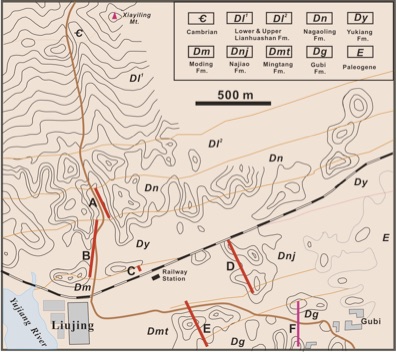Najiao Fm
Type Locality and Naming
The type section is located in nearby the Liujing railway station in Hengxian County, Guangxi.
It was named by Wang Yu, Yu Changmin and Fang Dawei in 1965.
Synonym: Najiao Dolomite
[Figure Simplified geological map of Liujing area showing the location of type sections of some lithostratigraphic units (red lines) A-Nagaoling Fm, B-Yukiang Fm, C-Moding Fm, D-Najiao Fm, E-Mintang Fm and Gubi Fm.]
Lithology and Thickness
Dolomite. It is characterized by medium- to fine-grained crystalline dolomite. The lower part consists of gray medium- to thick-bedded dolomite with dissolution pores, intercalated with gray to black fine grained dolomite. Small crinoid stem ossicles, fragments of stromatoporoids and tabulate corals are scattered occasionally. The middle and upper parts are composed of interbeds of laminated dolomite and crinoid dolomite with rare brachiopod individuals. It is more than 250 m thick.
[Figure Outcrop of Najiao dolomite at type locality near the Liujing Railway Station]
Relationships and Distribution
Upper contact
It is conformably in contact with overlying Mintang Fm.
Regional extent
The equivalent formation is distributed in Hengxian, Wuxuan, Litang, Beiliu and Jingxi of Guangxi with other names.
GeoJSON
Fossils
Lower part of the formation contains some fragments of crinoid stems and Stromatopora. In the Middle and Upper parts, a few brachiopods Zdimir sp., Megastrophia sp. have been found.
Based on the conodonts Polygnathus inversus, P. serotinus, P. C. costatus and Tortodus kockelianus are reported from different positions in the formation (Xiong, 1981; ai et al. 1982; Su, 1984).
Age
Depositional setting
Based on the fossil features the dolomite was secondary and has a normal marine origin, which is interpreted as a platform margin or upper slope facies.
Additional Information

